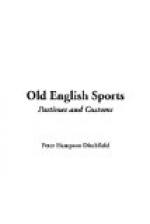Otter-hunting, now very rare, was once a favourite sport among villagers who dwelt near a river. Isaac Walton, in his book called The Complete Angler, thus describes the animated scene: “Look! down at the bottom of the hill there, in the meadow, checkered with water-lilies and lady-smocks; there you may see what work they make; look! look! you may see all busy—men and dogs—dogs and men—all busy.” At last the otter is found. Then barked the dogs, and shouted the men! Boatmen pursue the poor animal in the water. Horsemen dash into the river. The otter dives, and strives to escape; but all in vain her efforts, and she perishes by the teeth of the dogs or the huntsmen’s spears.
Foreigners are always astonished at our love of sport and hunting, and our disregard of all danger in the pursuit of our favourite amusement, and one of our visitors tells the following story: “When the armies of Henry viii. and Francis, King of France, were drawn up against each other, a fox got up, which was immediately pursued by the English. The ‘varmint’ ran straight for the French lines, but the Englishmen would not cease from the chase; the Frenchmen opposed them, and killed many of these adventurous gentlemen who for the moment forgot their warfare in the charms of the chase.”
But I must proceed to mention other February customs and sports. Great importance was attached to the Feast of the Purification, commonly called Candlemas Day (February 2nd), when consecrated candles were distributed and carried about in procession. At the Reformation this custom did not entirely disappear, for we find a proclamation of Henry viii., in 1539 A.D., which orders that “on Candlemas Day it shall be declared that the bearing of candles is done in memory of Christ the spiritual light, whom Simeon did prophesy, as it is read in the Church on




